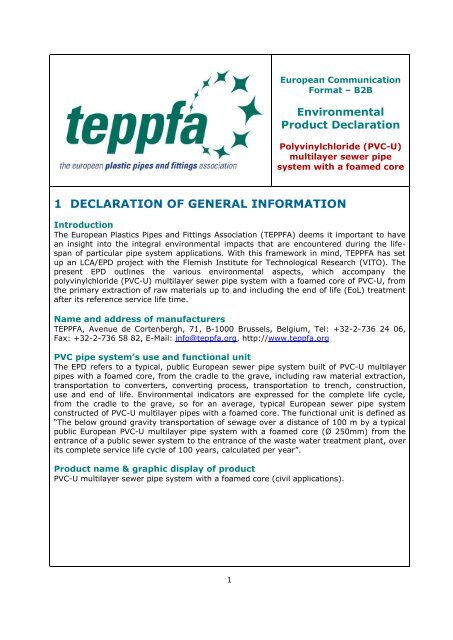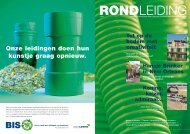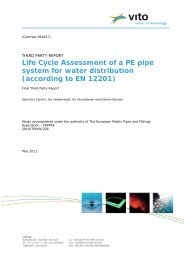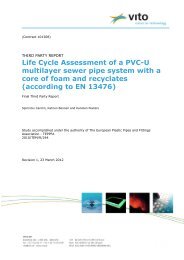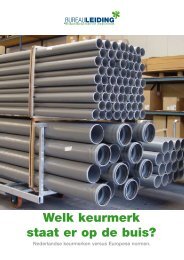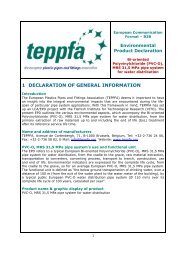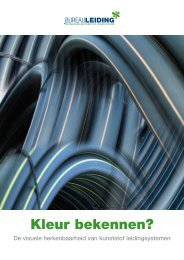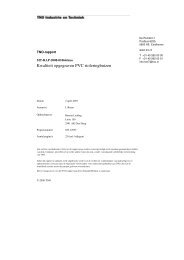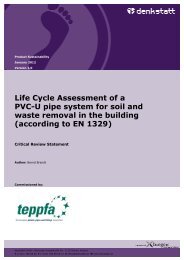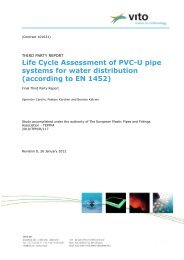1 DECLARATION OF GENERAL INFORMATION - BureauLeiding
1 DECLARATION OF GENERAL INFORMATION - BureauLeiding
1 DECLARATION OF GENERAL INFORMATION - BureauLeiding
Create successful ePaper yourself
Turn your PDF publications into a flip-book with our unique Google optimized e-Paper software.
European CommunicationFormat – B2BEnvironmentalProduct DeclarationPolyvinylchloride (PVC-U)multilayer sewer pipesystem with a foamed core1 <strong>DECLARATION</strong> <strong>OF</strong> <strong>GENERAL</strong> <strong>INFORMATION</strong>IntroductionThe European Plastics Pipes and Fittings Association (TEPPFA) deems it important to havean insight into the integral environmental impacts that are encountered during the lifespanof particular pipe system applications. With this framework in mind, TEPPFA has setup an LCA/EPD project with the Flemish Institute for Technological Research (VITO). Thepresent EPD outlines the various environmental aspects, which accompany thepolyvinylchloride (PVC-U) multilayer sewer pipe system with a foamed core of PVC-U, fromthe primary extraction of raw materials up to and including the end of life (EoL) treatmentafter its reference service life time.Name and address of manufacturersTEPPFA, Avenue de Cortenbergh, 71, B-1000 Brussels, Belgium, Tel: +32-2-736 24 06,Fax: +32-2-736 58 82, E-Mail: info@teppfa.org, http://www.teppfa.orgPVC pipe system’s use and functional unitThe EPD refers to a typical, public European sewer pipe system built of PVC-U multilayerpipes with a foamed core, from the cradle to the grave, including raw material extraction,transportation to converters, converting process, transportation to trench, construction,use and end of life. Environmental indicators are expressed for the complete life cycle,from the cradle to the grave, so for an average, typical European sewer pipe systemconstructed of PVC-U multilayer pipes with a foamed core. The functional unit is defined as“The below ground gravity transportation of sewage over a distance of 100 m by a typicalpublic European PVC-U multilayer pipe system with a foamed core (Ø 250mm) from theentrance of a public sewer system to the entrance of the waste water treatment plant, overits complete service life cycle of 100 years, calculated per year”.Product name & graphic display of productPVC-U multilayer sewer pipe system with a foamed core (civil applications).1
Description of the components of the PVC-U multilayer sewer pipe systemwith a foamed coreThe environmental burdens are calculated in relation to the functional unit, which resultedfor the typical European PVC-U multilayer sewer pipe system with a foamed core in thefollowing basic pipe system components: PVC-U multilayer pipes (with a core of foamedunplasticized PVC), PVC-U fittings, PP manholes and SBR sealing rings.The system consists of PVC-U multilayer pipes (foamed core) and fittings, red brown, SN 4,diameter 250 mm, 5 m length, socketed (representative for the typical pipe diametersfrom the entrance of a public sewer system to the entrance of the waste water treatmentplant).Manhole roughly every 45 meters (630 mm shaft – SMP report, 2005). The manholecovers are not included in the LCA study. Volume of fittings including seals (approximately5% of solid wall pipes’ volume) calculated based on actual sales data. The pipe system hasa reference length of 100 metres; slope 1/200 and filling rate 100%. Service life time of100 years.The EPD is declared as the average environmental performance for a typical EuropeanPVC-U multilayer sewer pipe system with a foamed core, over its reference service lifecycle of 100 years, calculated per year, in accordance to EN 13476-1, EN 13476-2, EN1295-1, EN 1046 and EN 1610.EPD programme and programme operatorThe present EPD is in line with the ongoing standardization work by CEN TC 350(prEN15804 and prEN15942). A programme operator related to the CEN TC 350 has notbeen established yet.Date of declaration and validityRevision 1, 23 March, 2012The EPD has a 5 year validity period (March, 2017)ComparabilityPlease note that EPDs of construction products may not be comparable if they do notcomply with the CEN TC 350 (prEN15804 and prEN15942) standards.2
Typical European PVC-U multilayer sewer pipe system with a foamed coreEPDThe present EPD outlines various environmental aspects, which accompany arepresentative average European PVC-U multilayer sewer pipe system with a foamed coreof unplasticized PVC, from the primary extraction of raw materials up to and including theend of life (EoL) treatment after its reference service life time of 100 years.Group of manufacturersThe EPD for the PVC-U multilayer sewer pipe system with a foamed core is representativefor an anticipated European typical PVC-U multilayer sewer pipe system. The TEPPFAmember companies represent more than 50% of the European market for extruded plasticpipes. For an overview of all members and national associations within TEPPFA we refer tothe last page of this EPD.Content of the product systemThe product system does not contain materials or substances that can adversely affecthuman health and the environment in all stages of the life cycle.Retrieve informationExplanatory material may be obtained by contacting TEPPFA (http://www.teppfa.org)2 <strong>DECLARATION</strong> <strong>OF</strong> THE MATERIAL CONTENTThe European Polyvinylchloride (PVC-U) multilayer sewer pipe system with a foamed coredoes not contain any substances as such or in concentration exceeding legal limits, whichcan adversely affect human health and the environment in any stages of its entire lifecycle.3 <strong>DECLARATION</strong> <strong>OF</strong> THE ENVIRONMENTALPARAMETERS DERIVED FROM LCA3.1 Life cycle flow diagramThe EPD refers to a typical European PVC-U multilayer sewer pipe system with a foamedcore, from the cradle to the grave, including product stage, transportation to constructionsite and construction process stage, use stage and end of life stage.Product stage: raw material extraction and processing, recycling processes forrecycled material input, transportation to the manufacturer, manufacturing(including all energy provisions, waste management processes during the productstage up to waste for final disposal):o Production of raw materials for PVC-U multilayer pipes with a foamed coreo Transportation of PVC-U multilayer pipe raw materials to convertero Converting process for PVC-U multilayer pipes with a foamed core(extrusion), including packing of the pipeso Production of raw materials for PVC-U fittingso Transportation of PVC-U fittings raw materials to convertero Converting process for PVC-U fittings (injection moulding), including packingof the fittingso Production raw materials for PP manholes3
oooConverting process for PP manholes (injection moulding), including packingof the manholesProduction raw materials for SBR ringsConverting process for SBR rings, including packing of the SBR ringsConstruction process stage: including all energy provisions, waste managementprocesses during the construction stage up to waste for final disposalo Transportation of PVC-U multilayer sewer pipe system with a foamed core tothe trencho Installation of PVC-U multilayer pipe system with a foamed core in thetrenchUse stage (maintenance and operational use): including transportation and allenergy provisions, waste management processes up to waste for final disposalduring this use stageo Operational use is not relevant for the PVC-U multilayer sewer pipe systemwith a foamed coreo Maintenance of the PVC-U multilayer sewer pipe system with a foamed coreduring 100 years of service life time in the trenchEnd of life stage: including all energy provisions during the end of life stageo Disassembly of PVC-U multilayer sewer pipe system with a foamed core after100 years of reference service life time at the trencho Transportation of PVC-U multilayer sewer pipe system with a foam core after100 years of reference service life time at the trench to an end-of-lifetreatmento End-of-life treatment of PVC-U multilayer pipe system with a foamed coreafter 100 years of reference service life time4
3.2 Parameters describing environmental impactsThe following environmental parameters are expressed with the impact categoryparameters of the life cycle impact assessment (LCIA).Impact categoryAbioticdepletionAcidificationEutrophicationGlobalwarmingOzone layerdepletionPhotochemicaloxidationkg Sb eq kg SO2 eq kg PO4--- eq kg CO2 eq kg CFC-11 eq kg C2H4 eqProduct stage 0,17168 0,04639 0,01348 14,77364 0,00000024 0,00264Construction process stage 0,04907 0,04557 0,01166 7,08671 0,00000092 0,00139Use stage 0,00380 0,00408 0,00098 0,55092 0,000000068 0,00011End of life stage 0,00008 0,00013 -0,00011 0,23735 0,000000011 0,000004Total 0,22464 0,09618 0,02602 22,64862 0,0000012 0,004143.3 Parameters describing resource inputThe following environmental parameters apply data based on the life cycle inventory (LCI).EnvironmentalparameterNon-renewableenergy indicatorRenewableenergy indicatorNon-renewablematerialresources (otherthan energy)Renewablematerialresources (otherthan energy)Crude oil(feedstock andenergy)Natural gas(feedstock andenergy)Input of netfresh waterMJ primary MJ primary kg kg kg kg m³Product stage 442,06481 17,67989 0,07483 0,46570 3,69339 3,10007 21,64752Construction stage 120,62769 3,24466 0,25195 0,01846 1,95877 0,19672 18,54930Use stage 8,60018 0,05974 0,01668 0,00065 0,15806 0,01387 0,39644End of life stage -0,00327 -0,10026 0,00192 -0,00180 0,02355 -0,00353 -0,31937Total 571,28941 20,88403 0,34538 0,48300 5,83377 3,30713 40,273893.4 Parameters describing different waste categories and further outputmaterial flowsThe parameters describing waste categories and other material flows are output flowsderived from the life cycle inventory (LCI).Parameters describing different waste categoriesEnvironmentalparameterHazardouswasteNon-hazardouswasteNuclear wastekg kg kgProduct stage 0,06461 0,39921 0,00030Construction stage 0,00010 0,92272 0,00019Use stage 0,00001 0,01365 0,000003End of life stage -0,000001 6,39635 -0,000007Total 0,06472 7,73193 0,000486
Parameters describing further output material flowsParameterComponents for re-useMaterials for recyclingMaterials for energy recoveryParameter unit expressed per functionalunit6,152 kg0,167 kg0,177 kg4 SCENARIOS AND TECHNICAL <strong>INFORMATION</strong>4.1 Construction process stageTransport from the production gate to the construction site (trench)ParameterFuel type consumption of vehicle orvehicle type used for transport e.g.long distance truck, boat etc.Capacity utilisation (including emptyreturns)Bulk densityVolume capacity utilisation factor(factor: =1 or 32t, EURO4/tkm/RER”Not relevant46 MJ of mechanical energy is needed forexcavating the soil (dig up), for excavating thebackfilling soil and sand, for the stampingprocess (compaction next pipe) and for thevibration plate (compaction top). Environmental7
urdens associated with this kind of energy arecalculated by means of the Ecoinvent V2.2datarecord “Diesel, burned in buildingmachine/MJ/GLO”Waste on the building site,generated by the product’sinstallationOutput materials as result of wastemanagement processes at thebuilding site e.g. of collection forrecycling, for energy recovery, finaldisposal0,1 kg of PVC-U multilayer pipe left leftover during installation: 80% to landfill, 15% toincineration and 5% to mechanical recycling.Transportation of PVC-U pipe left over to wastemanagement treatment facilities is included: 600km to recycling plant, 150 km to incinerationwith energy recovery and 50 km to landfill.Environmental burdens are calculated by meansof the Ecoinvent v2.2 datarecord “Transport,lorry 3.5-7.5t, EURO4/tkm/RER”.0,2 kg of packaging waste: treated accordingto European average packaging waste scenarios(EU27, 2006):Recycling Energy Recovery LandfillPlastic 27% 26% 47%Paper and board 75% 10% 15%Wood 38% 23% 39%Metals 66% 34%Total 57% 12% 31%0,36 m³ of soil that has to be transported overan average distance of 5 km to the nearestdepot. Environmental burdens are calculated bymeans of the Ecoinvent v2.2 datarecord“Transport, lorry 3.5-7.5t, EURO4/tkm/RER”.Emissions to ambient air, soil andwaterNo direct emissions at the trench. Emissions arerelated to the upstream processes (mining ofsand, transportation processes and mechanicalenergy) and downstream processes (wastemanagement and treatment) and are included inthe Ecoinvent datarecords that are used formodelling the environmental impacts.4.2 Use stage: operation and maintenanceOperation:Operational use is not relevant for the EPD, since it falls outside the system boundaries ofthe LCA project. Moreover the PVC-U multilayer sewer pipe system with a foamed core is agravity pipe system.Maintenance:Energy consumption for jetting: 5,4 kWh per FUWater consumption for jetting: 0,12 m³ per FUMaintenance in case of the PVC-U multilayer sewer pipe systems is specifically related tojetting. Jetting happens 4 times in a 100 year service life time. One jetting operation needsan energy consumption of 4 litre of gasoline and 3 m³ of water per 100 meter of pipesystem.8
4.3 End of lifeThe following end of life scenarios have been taken into account:Estimated reference service life time of 100 yearsEoL approach for landfill, incineration with energy recovery (impacts and credits areassigned to the life cycle that generates the waste flows)Recycled content approach for recycling and use of recyclates (= impact of recyclingand credits for recyclates, because less virgin materials are needed is assigned tothe life cycle that uses the recyclates)ProcessesCollection processRecycling systemFinal depositionParameter unit expressed per functional unitAfter a reference service life time of 100 years the PVC-Umultilayer sewer pipe system with a foamed core might bereplaced. In most cases (95%) the pipe system will be left inthe ground. In some cases (5%) the pipe system is taken outand treated (landfilled or incinerated).EO L sce na rio P V C pipe sM ec hanic al rec y c ling 2,5%Inc ineration 2,5%Left in ground 95%The transportation distance of the PVC-U pipe system from thetrench to a waste treatment facility depends on the treatmentoption. For mechanical recycling we assumed an averagetransportation distance of 600 km and for incineration anaverage distance of 150 km. Environmental burdens associatedwith transportation are calculated by means of the followingEcoinvent v2.2 datarecord “Transport, lorry 3.5-7.5t,EURO4/tkm/RER”5 ADDITIONAL <strong>INFORMATION</strong> ON EMISSIONS TOINDOOR AIR, SOIL AND WATER DURING USESTAGEEmissions to indoor air:Since the PVC-U multilayer sewer pipe system with a foamed core is a buried system (intrench) we can confirm that emissions to indoor air are not relevant.Emissions to soil and water:Despite there is no approved European measurement method available, we can confirmthat the PVC-U multilayer sewer pipe system with a foamed core does not contain anysubstances mentioned on the REACH-list.9
6 OTHER ADDITIONAL <strong>INFORMATION</strong>Product certification, conformity, markingEN 13476-1:2007, Plastics piping systems for non-pressure underground drainage andsewerage - Structured-wall piping systems of unplasticized poly(vinyl chloride) (PVC-U),polypropylene (PP) and polyethylene (PE) - Part 1: General requirements and performancecharacteristicsEN 13476-2:2007, Plastics piping systems for non-pressure underground drainage andsewerage - Structured-wall piping systems of unplasticized poly(vinyl chloride) (PVC-U),polypropylene (PP) and polyethylene (PE) - Part 2: Specifications for pipes and fittingswith smooth internal and external surface and the system, Type AEN 1295-1, Structural design of buried pipelines under various conditions of loading. Part1: General requirementsEN 1610, Construction and testing of drains and sewersENV 1046, Plastics piping and ducting systems - Systems outside building structures forthe conveyance of water or sewage - Practices for installation above and below groundIn compliance with European Construction Products Directive (89/106/EEC)Other technical product performancesFor the full overview of the environmental benefits of plastic pipe systems we will refer tothe TEPPFA website: http://www.teppfa.org10
TEPPFA member companiesAliaxisAlphacanEGEPLASTGeberit InternationalGeorg Fischer Piping SystemsKWH PipePipelife InternationalRehauTeraplastTessenderlo GroupUponorWavin11
REFERENCESEcoinvent Data v2.2, 2010, Swiss Centre for Life Cycle Inventories, SwitzerlandEN 13476-1:2007, Plastics piping systems for non-pressure underground drainage andsewerage - Structured-wall piping systems of unplasticized poly(vinyl chloride) (PVC-U),polypropylene (PP) and polyethylene (PE) - Part 1: General requirements and performancecharacteristicsEN 13476-2:2007, Plastics piping systems for non-pressure underground drainage andsewerage - Structured-wall piping systems of unplasticized poly(vinyl chloride) (PVC-U),polypropylene (PP) and polyethylene (PE) - Part 2: Specifications for pipes and fittingswith smooth internal and external surface and the system, Type AEN 1295-1, Structural design of buried pipelines under various conditions of loading. Part1: General requirementsEN 1610, Construction and testing of drains and sewersENV 1046, Plastics piping and ducting systems - Systems outside building structures forthe conveyance of water or sewage - Practices for installation above and below groundEurostat, 2006, Packaging waste scenarios (EU27, 2006)ISO 14025: Environmental Labels and Declarations Type IIIISO 14040: Environmental management – Life cycle assessment – Principles and frameworkISO 14044: Environmental management – Life cycle assessment – Requirements andguidelinesprEN 15804: Sustainability of construction works – Environmental product declarations – corerules for the product category of construction products (draft, 2008)prEN 15942: Sustainability of construction works – Environmental product declarations –Communication format – Business to Business (draft, April 2009)Simapro 7.3.0 – LCA Software, 2011, PRé consultants bv, Amersfoort, The NetherlandsSMP report, 2005 - Prof. Dr.-Ing. Stein & Partner GmbH – Bochum - European study of theperformance of various pipe systems, respectively pipe materials for municipal sewage systemsunder special consideration of the ecological range of effects during the service lifeBackground LCA report (ISO 14040and ISO 14044) prepared byVITO – Flemish Institute for TechnologicalResearch, Boeretang 200, B-2400 Mol,Belgium, Tel.: +32-14-33 55 11, Email:vito@vito.beExternal critical review of underlyingLCA byDenkstatt GmbH, Hietzinger Hauptstraße,AU-1130 Wien, Austria, Tel.: +43-1 786 8900, Email: office@denkstatt.at13


